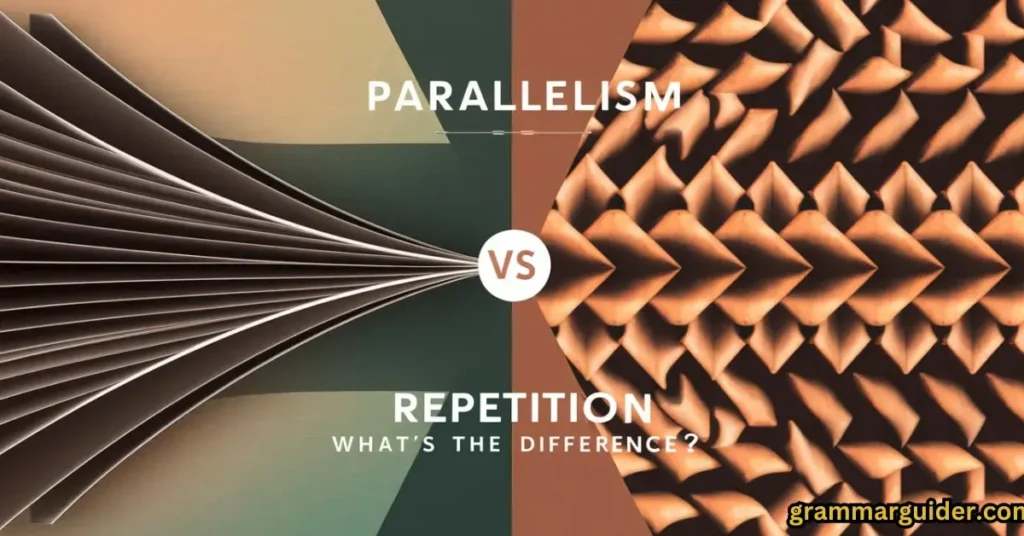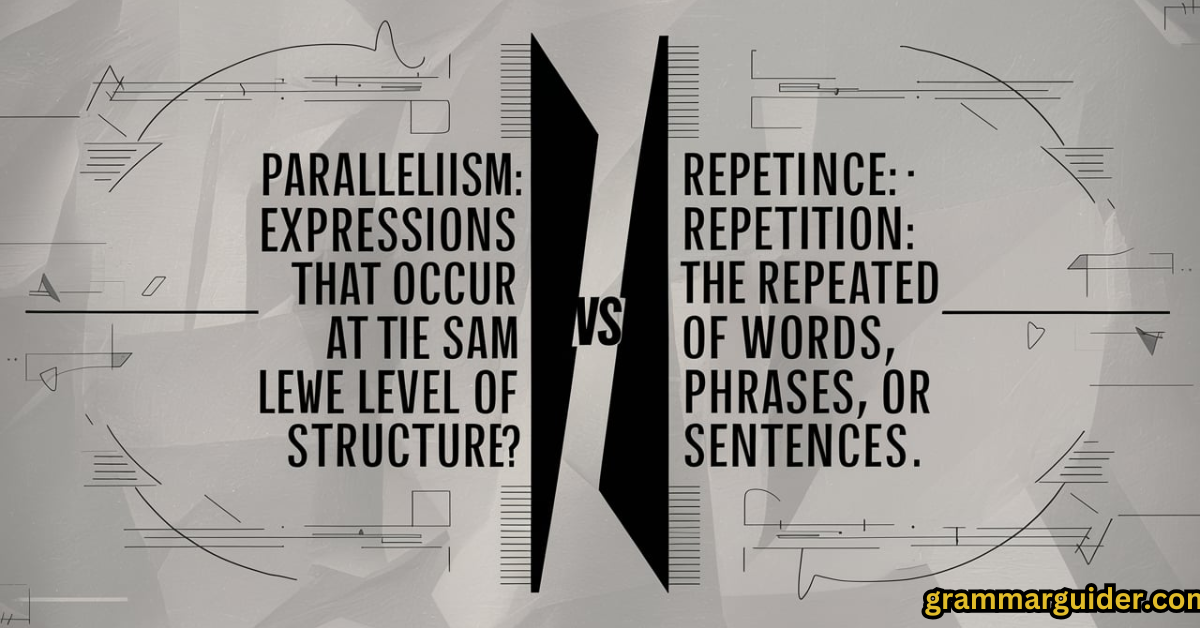In the realm of effective communication, whether in writing or speaking, the use of certain rhetorical devices can significantly enhance clarity, style, and impact. Two such devices—parallelism vs repetition—are commonly used to strengthen writing, especially in contexts like speeches, essays, and emails. However, these two devices, though both effective, are fundamentally different in how they function.
In this article, we’ll explore the difference between repetition and parallelism, illustrating with examples in emails and other contexts to clarify when and why each is used.
Understanding Repetition
What is Repetition?
Repetition is the act of repeating words, phrases, or sentences to emphasize a particular point or create a rhythmic flow. This technique often reinforces an idea, making it more memorable or stressing its importance.
Repetition can appear at various levels of writing—from the repetition of a single word to entire phrases or sentences. Writers use repetition when they want to emphasize their point or evoke a specific emotional response from their audience.
Why Use Repetition?
Repetition is primarily used to draw attention to key points, ensuring that they stick in the reader’s or listener’s mind. It’s a technique frequently employed in advertising, speeches, and persuasive writing. In emails, repetition can underscore urgency or reinforce a request.
For example, repeating a call to action or a specific deadline ensures that your message stands out. It can also serve to motivate or convince an audience by making the message resonate more deeply.
Example of Repetition in an Email
Imagine you’re sending an email to a colleague, John, to remind him about an urgent deadline. Here’s how you could use repetition:
Subject: Urgent Deadline Reminder for Project X
Dear John,
I hope you’re doing well. I just wanted to quickly remind you about the deadline for Project X tomorrow. The deadline for Project X is tomorrow. It’s crucial that we meet this deadline to ensure everything stays on track.
Thank you for your attention to this matter.
Best regards,
David
In this email, the repetition of the phrase “deadline for Project X” emphasizes the urgency of the task. By repeating it multiple times, you ensure that the reader doesn’t miss the critical point.

Understanding Parallelism
What is Parallelism?
Parallelism (or parallel structure) involves using similar grammatical structures to convey related ideas. It creates balance and symmetry in writing, making it easier to read and understand.
The purpose of parallelism is to show the relationship between ideas in a way that flows smoothly, offering a clear and organized structure that guides the reader through the material.
Why Use Parallelism?
Parallelism enhances the rhythm and clarity of writing. By keeping the structure consistent, it helps readers quickly grasp the point being made, improving the overall flow and coherence of the sentence or passage.
This makes the writing easier to follow, and it also ensures that each part of a list, comparison, or contrast is treated with equal importance. In emails, for instance, parallel structure helps readers quickly identify the key points or tasks being discussed.
Example of Parallelism in an Email
Let’s consider an email where you’re outlining tasks for a team project. The use of parallel structure ensures that each point is equally important and easy to follow:
Subject: Project X – Task Allocation
Hi Team,
As we prepare for the next phase of Project X, here’s the breakdown of tasks:
- Research the latest market trends.
- Develop a detailed marketing plan.
- Collaborate with the design team on graphics.
- Finalize the budget and financial projections.
Each of these tasks is equally important, and by keeping the structure of the items parallel (each starting with an action verb), the email feels organized and clear.
Repetition vs Parallelism: What’s the Difference?
While repetition vs parallelism both serve to enhance writing, the difference between them lies in how they are used and the impact they create. Let’s break this down in more detail.
Key Differences
| Aspect | Repetition | Parallelism |
|---|---|---|
| Definition | The reuse of words, phrases, or ideas to emphasize them. | The use of consistent grammatical structures. |
| Function | To create emphasis, rhythm, or memorability. | To create balance and clarity in related ideas. |
| Effect on Reader | Can be powerful but may become monotonous if overused. | Enhances readability and coherence in writing. |
| Common Uses | Advertising, speeches, persuasive writing. | Lists, comparisons, and sentence structure. |
| Example | “I will not stop. I will not give up. I will succeed.” | “She likes swimming, biking, and running.” |
The difference between parallelism and repetition lies in the underlying structure and purpose. Repetition is more about emphasis, while parallelism is about structural consistency.
When to Use Repetition
Use repetition when you need to:
- Emphasize a point.
- Reinforce an important idea.
- Create a rhythmic or musical quality in your writing.
When to Use Parallelism
Use parallelism when you need to:
- Present a list of items or ideas.
- Compare or contrast things.
- Maintain clarity and smooth flow in a sentence or paragraph.
Scenarios and Examples: Repetition vs Parallelism
Scenario 1: Email Reminder for a Meeting
Let’s look at two variations of an email reminder for a meeting. One uses repetition, and the other uses parallelism.
Email with Repetition
Subject: Reminder: Meeting Tomorrow
Hi Sarah,
Just a quick reminder about the meeting tomorrow. The meeting is at 10 AM, and the meeting will be held in the conference room. Please don’t forget, the meeting is very important.
Thanks,
Emily
Here, the word “meeting” is repeated multiple times to emphasize its importance. The repetition helps the recipient remember the key information.
Email with Parallelism
Subject: Reminder: Meeting Tomorrow
Hi Sarah,
Just a quick reminder about the meeting tomorrow:
- Prepare your presentation.
- Review the budget updates.
- Bring any questions for discussion.
Looking forward to seeing you tomorrow at 10 AM!
Thanks,
Emily
This email uses parallel structure by listing tasks in the same grammatical form. Each bullet point starts with an action verb, making the email easy to read and follow.
Scenario 2: A Persuasive Speech
Consider a scenario where a speaker wants to persuade the audience to support a cause. Let’s see how repetition and parallelism play out in this context.
Speech with Repetition
“We must act now. We must act for the future. We must act for the children.”
In this speech, the repetition of the phrase “We must act” is used to create urgency and emphasize the importance of taking action. The repetition has a rhythmic, almost chant-like quality that draws the listener in.
Speech with Parallelism
“We must act for the environment, we must act for our economy, and we must act for our future.”
Here, the speaker uses parallelism to create a balanced structure, with each item in the list starting with “we must act for” and followed by a key area of concern. This creates clarity and rhythm while presenting related but distinct points.

Parallel Structure vs Repetition: When to Choose Each One?
When deciding whether to use parallel structure vs repetition, it’s important to consider the purpose of your writing. Let’s break it down.
When to Choose Parallelism
Choose parallelism when:
- You want to present a list of ideas or actions that are equally important.
- You need clarity and balance in your sentence construction.
- You are comparing or contrasting multiple items.
When to Choose Repetition
Choose repetition when:
- You want to emphasize a particular idea or point.
- You want to make your message more memorable.
- You want to create a rhythmic or emotional effect in your writing.
Final Thoughts
Both repetition vs parallelism are valuable tools in the writer’s arsenal. They each serve different functions, and knowing when to use them can dramatically improve the effectiveness of your communication. Repetition is ideal for emphasizing key points, while parallelism provides balance and clarity, especially in lists or comparisons.

Harley Rose is a seasoned expert in English grammar and writing tips, blending years of knowledge and a love for language into her work. With a sharp eye for detail and a talent for making grammar accessible, Harley shares practical insights that help readers write with precision and flair. Her content is ideal for anyone looking to strengthen their writing skills and express themselves with confidence.

